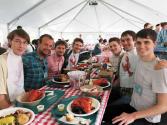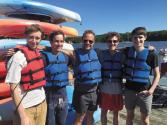Meeting physics pioneers
Gordon Research Conference on Liquid Crystals
June 21, 2015 to June 26, 2015
Medford, MA
By:Andrew Mascioli, Class of 2017, and Ian Hunter, Class of 2016
SPS Chapter:

Standing in front of my poster, I (Andrew) spoke in detail about one of the methods I used to perform the simulations in my work. As I was about to continue, a senior researcher in the small crowd listening to me interrupted me with a question. I listened intently as he described the work of a leading researcher in the field who had done work related to mine but with different methods. Another person jumped in with a comment.
Soon a discussion emerged. Criticisms and praise for one method or another were tossed around, and I threw my own opinions into the mix. Afterward, ideas about how I could improve my own research ran through my head.
Those kinds of interactions defined the Gordon Research Conference (GRC) we attended in secluded Biddeford, Maine. In a town that seemed more suited for a summer camp than a scientific conference, 150 top researchers, students (mostly graduate students), and industry professionals gathered to discuss liquid crystals. Liquid crystals are materials that flow like liquids but have long-range order like crystals. Responsive to both light and applied fields, they are a key component in displays, electronic paper, and, as we learned, artificial muscles and sensors.
The atmosphere was informal and casual. Conversations about cutting-edge research went hand-in-hand with social activities such as kayaking. With the understanding that all research information shared at the conference was confidential, the discourse flowed freely.
“We don’t know yet,” we heard again and again, as participants discussed new, exciting observations that had yet to be explained. The GRC sets itself apart as a different kind of conference that embraces the spirit of collaboration in the pursuit of scientific progress. One of this year’s conference vice chairs and an established liquid crystal experimentalist, Professor Linda Hirst from the University of California, Merced, told us that the primary goals of the GRC are to encourage collaboration, get graduate students to talk to established professors, and avoid cliquishness. Hirst saw those goals as distinct from those of larger conferences, which often serve primarily as a means for scientists to display their completed work.
The opportunity to attend such a conference as an undergraduate not only proved to be a boon for our own research, but also shaped our opinion of the scientific community. If nothing else, the GRC inspired us to continue being engaged in that community.
Next up
Peruse the full lineup of Gordon Research Conferences at www.grc.org.
Areas of Alignment:

